Invertebrates living on the Atlantic Ocean's floor are helping scientists see the effects of dwindling global biological diversity.
These invertebrates show how local species extinction can alter the ocean's ecology and decrease the volume of ocean life, said an international team of scientists that includes UW-Madison researchers, in the Nov. 12 issue of Science.
Crabs, starfish, marine worms and others burrow into the top six inches of the ocean's mud, where they mix sediments, shift nutrients and add oxygen to the ocean's bottom. The churning of these sediments helps cycle vital nutrients through the ocean's food chain.
\What goes on in these six inches has a huge influence in global productivity,"" said Brad Cardinale, a UW-Madison postdoctoral research associate of zoology and co-author of the paper.
Scientists studied a patch of ocean floor off the coast of Ireland. They slammed a camera that measures oxygen levels into the ocean's floor, and took samples of floor sediments to count the species in them. Then the researchers incorporated these data into computer models to predict the ecological changes that might occur when species go extinct.
""It's a what-if scenario,"" Cardinale said of the computer modeling. ""What happens when these species go extinct?""
The team focused on the size of each animal, its mobility and how deep it dug into the ocean's mud-all factors that influence the sediment composition.
Previous ecological models assume species extinction is a random event, Cardinale said, which is misleading. Different animal types have unique contributions to ocean life, and all have different probabilities of extinction. Some extinction is random, he said, but it also depends on the organism's size, its prevalence and the pollution in its environment.
Every model revealed the same outcome: ""The sediments turned less, and nutrients stopped recycling,"" Cardinale said, which is bad news for the ocean.
""Without nutrients, there is no biological growth at all,"" said Teresa Balser, a UW-Madison assistant professor of soil and ecosystem ecology.
Nutrients like nitrogen, phosphorus and carbon cycle at different rates, Balser said, which is crucial for species success.
""We are going to lose in all models,"" Cardinale said, ""but the order of extinction is important. All the important details are dependent on how the species go extinct.""
The next step, Cardinale said, is to simulate the computer models in the lab, with real animals and real sediment to get ""a much better handle about why these are going extinct. We want to generalize this for other ecosystems.\





